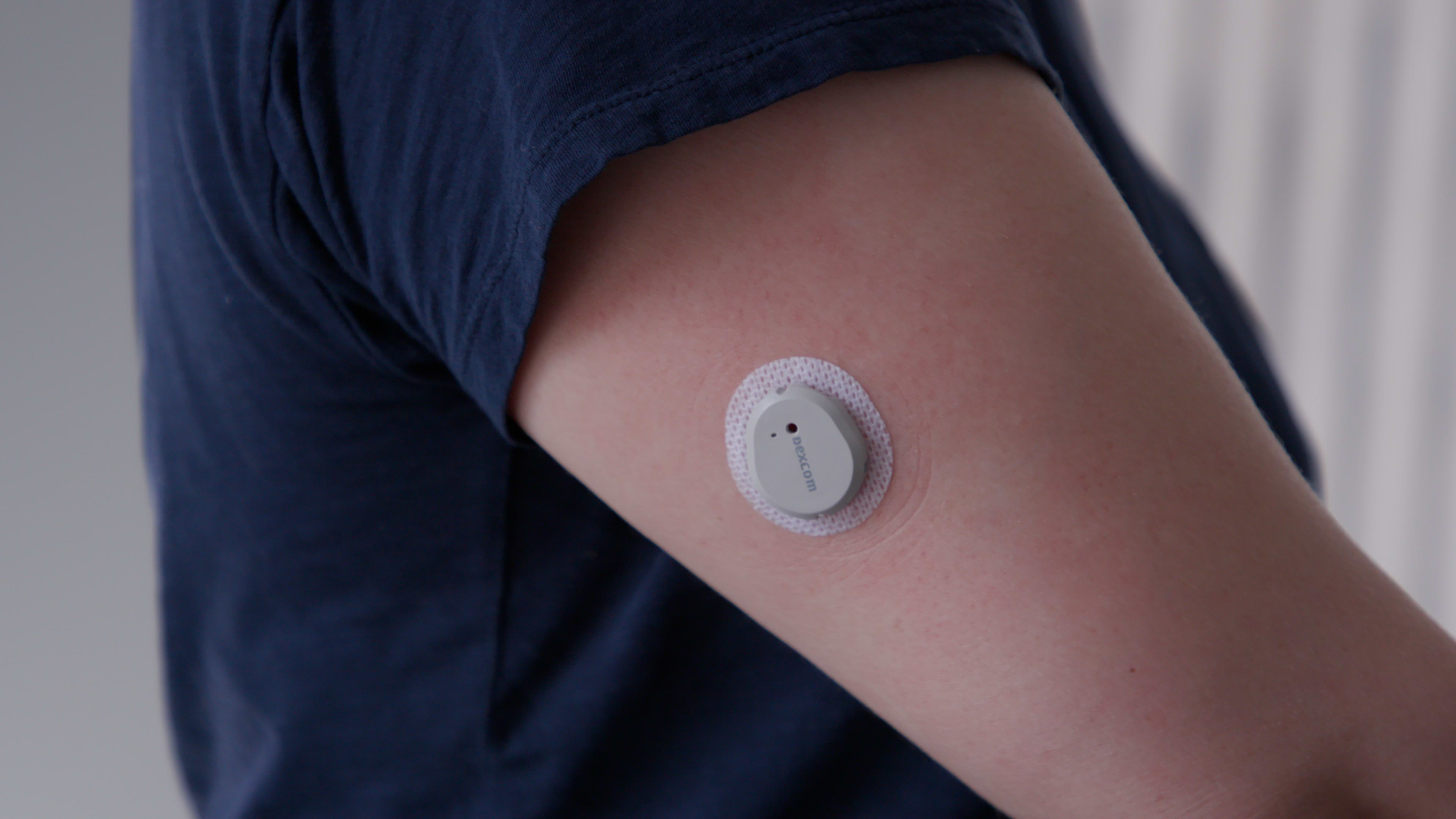User wearing Stelo CGM from Dexcom.
Courtesy of Dexcom
Dexcom on Monday announced its new over-the-counter continuous glucose monitor Stelo is officially available for purchase in the U.S.
Glucose is a type of sugar people receive from food, and it’s the body’s main source of energy. Continuous glucose monitors, or CGMs, are small sensors that poke through the skin to measure glucose levels in real time. They are typically prescribed to patients with diabetes since they can help alert users, their loved ones and their doctors to emergencies.
Stelo is primarily intended for patients with prediabetes or Type 2 diabetes who do not use insulin, though individuals without either condition can also purchase it. Users can buy a one-month supply online for $99, or sign up for an ongoing subscription at $89 a month.
Dexcom said patients also have the option to use their Flexible Spending Accounts and Health Savings Accounts to pay for Stelo, according to a statement.
The company already offers continuous glucose monitors for Type 1 and Type 2 diabetes patients, but Stelo is Dexcom’s first product that does not require a prescription. While most Type 1 patients can already get insurance coverage for the sensors, Stelo is now accessible to millions of Type 2 patients who have been unable to get prescriptions or coverage. It also marks the company’s official foray into a new and potentially lucrative prediabetes market.
Dexcom said there are more than 125 million Americans with prediabetes or Type 2 diabetes not using insulin, according to a statement. The company designed Stelo to help teach this patient population how to keep their glucose levels within a healthy range.
“The idea is to help people, over time, learn about diet choices and habits and how those are impacting glucose,” Jake Leach, chief operating officer at Dexcom, told CNBC in an interview. “It’s about uncovering things you haven’t seen before and then using that to create healthier habits.”
How it works

The U.S. Food and Drug Administration approved Stelo in March. It was the first over-the-counter continuous glucose monitor to be cleared for use, though Dexcom’s competitor Abbott received clearance for two similar devices in June.
Leach said Dexcom is working with Amazon to fulfill Stelo deliveries. Users with a subscription can choose to skip or adjust their delivery date, but it will typically be scheduled at the 30-day interval from their initial sign up.
Stelo is worn on the upper arm and lasts for 15 days before it needs to be replaced. It’s gray, about the size of a quarter, and around half an inch thick.
The sensor wirelessly transmits data to a smartphone app. When users are getting set up, they’ll select whether they have Type 2 diabetes, prediabetes or none of the above. This helps establish their “Target Range,” which is where Dexcom wants users to try and keep their glucose levels. The target range is based on established medical standards, and most people fall between 70 and 180 mg/dL, according to the American Diabetes Association.
When they open the Stelo homepage, they’ll see their latest reading, which is updated every 15 minutes. They’ll also see a graph of their readings each day, which includes a shaded green area to indicate the target range. If they scroll down, they’ll see a summary of the time spent in the target range over time.
Everyone’s glucose levels are variable, but Stelo will send users a notification when they are experiencing a substantial spike. Glucose spikes occur when the amount of sugar present in the bloodstream rapidly increases and then decreases. This often happens after eating.
In the short term, spikes can cause feelings of fatigue, but high glucose levels can lead to more serious health problems like diabetes, heart disease and kidney disease over time, according to the Centers for Disease Control and Prevention. This is why Dexcom wants users to try and keep their levels within Stelo’s target range.
The tab next to the home page is the “Events” page, which is where Stelo users can log meals, activity, fingersticks or other notes. Leach said it’s most important for users to log an entry when they’re experiencing a big spike so that they can reflect on what might be causing it.
Stelo notifies users about noteworthy spikes, so they won’t necessarily get alerted every time their levels rise. Leach said this is an intentional design choice that’s meant to call attention to the larger swings that patients experience.
“Even for someone who has normal glucose and the occasional spike, it’ll look for the most impactful spikes and then try to engage the user around, ‘Okay, what happened there?'” he said.
And for users who want to dig deeper into their glucose and understand what causes spikes, there’s a trove of educational materials in the app’s “Learn” tab. The articles are brief, sometimes only a few sentences, and they’re broken down into categories like “Stelo Basics,” “Glucose Deep Dive,” “Nutrition,” “Exercise,” “Sleep” and “Stress.”
CNBC Tests Stelo
The Stelo app
Courtesy of Dexcom
I’ve been testing Stelo since early August. On the whole, I think it’s been easy and helpful to use.
When my monitors arrived in the mail, the first order of business was applying the sensor to my arm and pairing it with the Stelo app. I found this process very straightforward – the app walked me through what to do with clear, step-by-step instructions.
I cleaned the back of my right arm, placed Dexcom’s applicator there, pressed the button and popped the CGM right on. It happens fast and doesn’t hurt at all.
The monitor connects to the Stelo app via Bluetooth, and then it takes about a half hour to warm up.
This is where I initially encountered some problems. Once my device had warmed up, I got an error message that said “Brief Sensor Issue.” The message told me not to take off the CGM, and that the issue was temporary. I left it on for the day, but by evening, I noticed some light bleeding. I decided to take that sensor off.
I applied another CGM to my other arm, and that one warmed up and worked correctly. I’ve been wearing it ever since and haven’t had any trouble with bleeding. Leach said if users have problems with the product, they can message the chat interface on Stelo’s website to get a replacement or answer their questions there.
Once I was all up and running with my second sensor, it was smooth sailing.
I’ve found the Stelo app simple and easy to use. I never felt like I was being overloaded with too much data or too many notifications, and logging meals and exercise is very straightforward. Users can also choose to import their sleep and activity data from the Apple Health app or Android’s Health Connect app, which I think is a nice touch.
If it’s your first time using a CGM, I definitely recommend reading through the articles in the “Learn” tab. I think Dexcom does a good job using plain language to explain what glucose is, what affects it and why it matters.
The longer I wear the sensor, the more I can tell that the algorithm is tuning to me and my habits. I don’t get notifications each time my glucose spikes, but it does alert me when I’m experiencing a particularly substantial jump. The app is also beginning to pick up on my patterns. For instance, it recently told me that my glucose tends to spike between 5 p.m. and 7 p.m., which is usually around when I eat dinner.
Most of the time, I forget I’m even wearing a sensor. It’s waterproof, so I didn’t need to worry about it in the shower. And I didn’t notice it when I was sleeping. I’d advise a little caution when pulling on long sleeves, as the sensor can snag a bit, but it’s easy to wear all types of clothes and jackets over it.
In the short time I’ve been using Stelo, I’ve learned a lot about how my body responds to certain foods. Even small adjustments (eating carbs last, for instance) helped me reduce spikes. It’s easy to see how CGMs can serve as a valuable window into the body. If you’re looking for a simple, approachable entry to understanding your glucose data, I think Stelo is a solid option.

